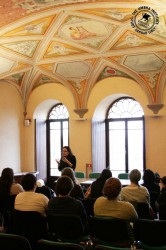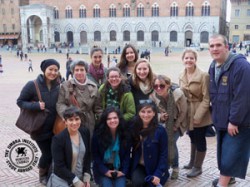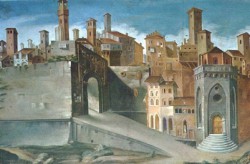Academic and Non-Academic Internships
Summer Internship
The Umbra Summer Internship launched last year and was a great success. Food Studies Program students interned with Lungarotti, one of the largest Umbrian wineries, to help the company improve its online presence. In Summer 2013, the summer internship will be at Castello Monte Vibiano, another local winery that is certified zero emissions. Umbra began collaborating with Monte Vibiano on a year-long service learning project in September 2012 for the BUFS 380: The Business of Food: Italy and Beyond class. This project will conclude this summer with a student from University of Denver from the Fall 2012 semester returning to intern with them. Her role will be to conduct market research about a possible product launch in the U.S. market. The internship is non-credit bearing, and students receive housing in the historical center of Perugia.
Education: POST Science Museum
Students in the INIT 350: Academic Internship and Seminar – Education are participating in a new service learning project with the POST Science Museum of Perugia, creating educational science videos for elementary school students. These videos will be part of interactive workshops using Smartboard technology and hands-on experiments that incorporate English language learning. Umbra students will lead their video and workshop once they are completed both at the museum and in the classroom. This is an exciting project for both Umbra students and the museum as they work together on this pilot project, creating the very first videos specifically designed for elementary school students.
In this academic internship and seminar, students examine educational psychology, pedagogical models, and English language teaching methods. Students intern with either a local public scientifico or Montessori high school, working closely with English language teachers and Italian students. Depending on the placement and the teachers’ needs, student interns either assist with lesson planning and classroom instruction or design and implement English language workshops with a specific theme such as music or travel. Both the internship and the new service learning project with POST allow students to experience theory discussed in the seminar part of the course.
Urban Engagement
The INIT 350: Academic Internship and Seminar- Urban Engagement course works closely with the Borgo Bello neighborhood association to explore the relationships among culture, history, and people in this unique part of Perugia. The Borgo Bello Association and Umbra students discuss the regeneration of the neighborhood, its main issues, and goals to shape the semester’s projects. Students meet with the association’s president, American ex-pats, museums, theaters, and businesses in the area to gain insight into how new initiatives are shaping the current sentiment with locals and tourists. Past projects have included repainting civic numbers and organizing a photography exhibit, bringing visitors and residents closer to the community.
Service Learning
International Marketing
Students in BSIM 390: International Marketing collaborate each semester with a local Italian business that has developed or would like to develop business relations with the United States. The Spring 2013 students are working with the eco-friendly winery Castello Monte Vibiano. Having toured the facilities and met with the owners, students will analyze and present marketing strategies that utilize social media to increase current and future sales of their zero-emissions wine.
Creative Writing
Students in the CWIT 340: Italian Tales and Stories: Creative Writing Through Literary Models course cooperate with an Umbrian local online newspaper, La Nazione, where they meet with Italian journalists to see their newspaper operations firsthand. Afterwards, students will write and submit articles in English for their website. At the end of the semester, the class will wrap up the semester with a Creative Writing Readings for the Umbra community.
Archaeological Discoveries
The ARAA 320: Archaeological Discoveries: A Passion for Classical Antiquity class is working with the Museo Archeologico Nazionale dell’Umbria to improve the way the museum welcomes international English-speaking visitors. Students will develop a project of their choice that assists the museum in attracting these visitors by researching the museum’s current practices and marketing efforts. The service learning project will help visitors understand the museum within the context of historic and modern Perugia through informative print material.




